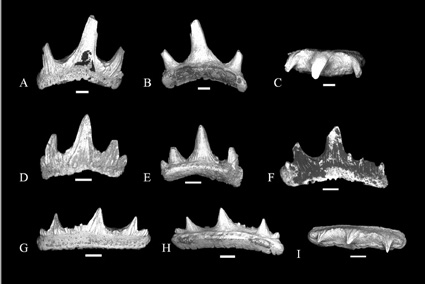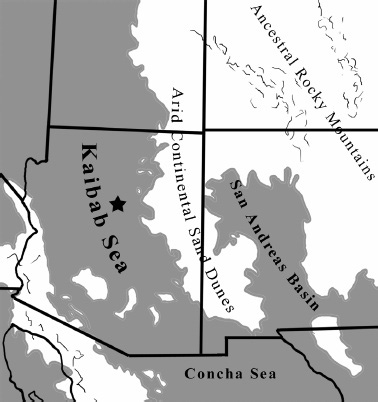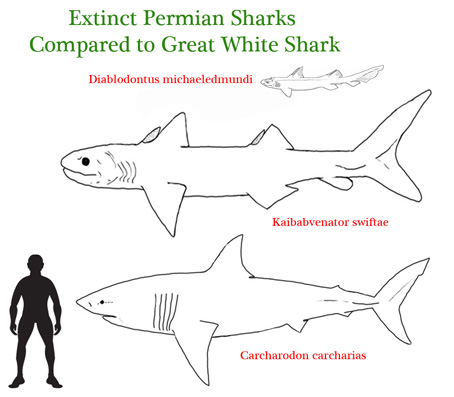New Species of Prehistoric Shark Described – Meet “Devil Tooth”
Arizona may be one of the very last places you would expect to find a new species of shark, after all, the “Grand Canyon State” does not seem particularly shark friendly when you consider the large amount of desert within the state’s borders. However, during the Middle to Late Permian (Guadalupian/Lopingian Epochs) this part of the United States was covered in a shallow, tropical sea that teemed with life and scientists from the Northern University of Arizona have identified a number of new shark genera from fossilised teeth excavated from the limestone deposits that make up the Kaibab Formation.
Diablodontus michaeledmundi
Their latest discovery is “Devil Tooth” a new type of hybrodont shark Diablodontus michaeledmundi. Hybrodont sharks evolved during the Late Devonian and persisted as a diverse and geographically dispersed group until their extinction towards the end of the Mesozoic. D. michaeledmundi seems typical of this group of Elasmobranchs, the teeth, the researchers have found, suggest that this shark was a little over a metre in length and it was probably a diurnal hunter, living in the coastal waters hunting small fish, squid and octopi.
An Illustration of Diablodontus michaeledmundi
Picture credit: Northern Arizona University with additional annotation by Everything Dinosaur
Hybrodont Shark
This shark had two spines projecting upwards from the anterior edge of its dorsal fins, such horned sharks exist today, such as the Port Jackson shark, although extant sharks such as the Port Jackson shark are not closely related to these Permian Elasmobranchs. The name Diablodontus is derived from the Spanish word for devil “diablo” and the Greek word for teeth “dontus”. The species name honours Michael Edmund Hodnett, for his work in helping to study the shark fossil assemblage of the Kaibab Formation.
The Kaibab Formation has produced a substantial amount of shark teeth fossils. This strata is particularly important as it dates from around the time of the greatest mass extinction event known in the fossil record – the end Permian extinction when something like 95% of all life on Earth died out. The holotype material for D. michaeledmundi was collected from limestone sediments near the town of Flagstaff (northern Arizona).
Various Views of the Fossilised Teeth of Diablodontus michaeledmundi
Picture credit: John-Paul M. Hodnett et al
The image above shows various views of the teeth of this prehistoric shark. The white bar is a scale bar, it is 1 mm in length.
Shallow Sea in North America
Commenting on the discovery, one of the authors of the scientific paper John-Paul Hodnett, an authority on prehistoric sharks stated:
“The shark miraculously survived the extinction event and lived into the Mesozoic Era – the Age of Reptiles. At this time the ancestors of modern sharks were just starting to diversify but remained small.”
During the Late Palaeozoic, this part of America was covered by a shallow sea, to the east lay extensive deserts crossed by a nascent mountain range, mountains that would one day become part of the Rockies.
Arizona During the Late Permian
Picture credit: John-Paul M. Hodnett et al
The Kaibab Formation
Fossilised sharks teeth from the Kaibab Formation has permitted scientists an insight into the radiation and diversification of a number of different types of shark. Several different genera have been identified, one of which Kaibabvenator swiftae with its large, serrated teeth was perhaps the apex marine predator in the ancient Kaibab sea. Size estimates vary for K. swiftae, although it has been suggested that this primitive, horned shark may have reached lengths similar to today’s Great White shark (Carcharodon carcharias).
Size Comparisons between Permian Sharks of the Kaibab Formation and a Great White Shark
Picture credit: Northern Arizona University/Everything Dinosaur
One thing that is undeniable, the Kaibab Formation represents one of the most important locations in the world for fossils of ancient sharks.
For models and replicas of prehistoric sharks and other extinct creatures: PNSO Age of Dinosaurs Models and Figures.









Leave A Comment